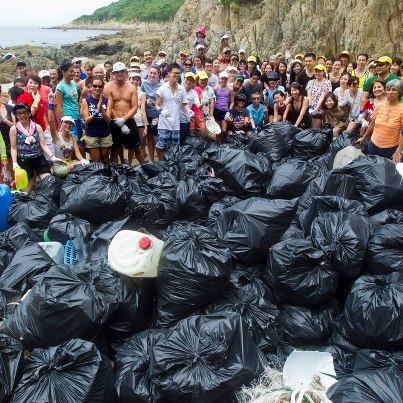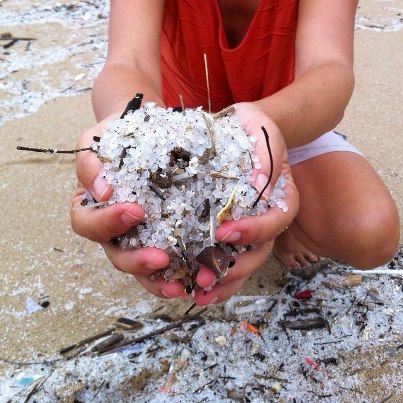More than 150 tons of plastic pellets manufactured by SINOPEC were spilled into the sea when Typhoon Vicente hit Hong Kong on 23 July, 2012. However, the Hong Kong government neither announced the incident to the public nor took action to clean-up the pollution until citizens found the plastic pellets on local beaches. Currently, environmental groups are still coordinating the clean-up action via Facebook.
The first online report was written by Gary Stokes of Sea Shepherd Hong Kong and he also created a Facebook page to follow up the incident:
After the recent Typhoon 10 that hit Hong Kong a few days ago, a grim discovery was made by Tracey Read on Discovery Bay’s North Beach. A total of thirty 25kg sacks of Pre Processed Plastic [Raw Plastic in small pellet form also known as Nurdles] was found washed up on the beach. Sadly 11 of the sacks were empty and their contents now lay strewn across the beach. Plastic is one of the largest pollutants in the worlds oceans today. These small translucent balls look very similar to fish eggs and because of this they are consumed by fish and seabirds. The Nurdles absorb all pollutants before they are ingested, passing these toxins onto the host. Once in the food chain, plastic then works it’s way up the food chain and eventually ends up on the human dinner table.
The news was mainly spread amongst English speakers and was briefly reported in the South China Morning post on July 31. The Facebook group quickly produced an advocacy video to raise public concern:
Not until the Discovery Bay-based environmental group, DB Green, made a public call for volunteer clean-up action via a Chinese online forum on August 2, did the local Chinese mainstream media pick up the story. A full page report appeared in Apple Daily [zh] on August 4.
Pressured by journalist inquiries, the government finally admitted on August 5, that they had received reports from SINOPEC about the incident soon after the typhoon but they stressed that the pellets are not toxic. However, local fish farm owners have reported that [zh] their fishes have been ‘stuffed’ to death by eating the plastic pellets.
Although both the government and SINOPEC have promised to help with the clean-up, the public have been outraged by the delayed response and following DB Green's example, citizen groups such as Lamma Corner, Scholarism, Green Sense have also called for clean-up actions.

More than a hundred volunteers showed up at Shek O beach on August 12, 2012. Photo from Plastic Disaster on Facebook.
In addition, a Google Map has been put up for coordinating the clean-up:
View Plastic Disaster in a larger map
A month has passed since the incident and citizens continue to share clean-up tips and update on new plastic pollution areas online:








1 comment
How can this be used against enemy incursions in the strategic locations where Japanese pirates followed by Japanese military were wont to be. They’re pellets not mines, right?